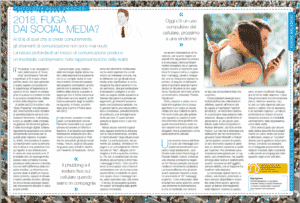
The future of work
14 February 2019
StoryTelling for Leader
25 February 2019“PSYCHOLOGY OF EMOTIONS” column by Diego Ingrassia – “2018, ESCAPE FROM SOCIAL MEDIA?”
for PSICOLOGIA CONTEMPORANEA – New Reports – no. 268, July-August 2018 – GIUNTI EDITORE
“Phubbing” is a neologism born from the fusion of “snubbing” and “phone”, the meaning is all too clear because I believe that having generated or undergone this behaviour belongs to everyone’s experience: being in someone’s company and being glued to your smartphone, distracting yourself from the real relationship. Since 2013, the website ‘Stop Phubbing’ has been active, which through data, information and various awareness-raising initiatives tries to counter this phenomenon. Phubbing is only one aspect of the complex galaxy of phenomena generated by digital technologies, however, it very well represents a decidedly dangerous drift for the quality of relationships: it is evident, in fact, that the practice of this behaviour places the person who engages in it in a one-up position with respect to his or her interlocutor in the flesh next to him or her. This is likely to happen very often in the complete unawareness of the persons involved, but not in the indifference of their emotional side.
The one-up/one-down dynamic is in fact a powerful mechanism, capable of activating our emotional brain, at the origin of numerous relational pathologies that can lead to real conflicts. Understanding what the use ofdigital technologies has changed in the relationship between people is not an easy task; research on the subject often provides somewhat conflicting data, also because the objective of the research is not always clear; to this we should add that these are still recent phenomena: the pervasive diffusion of smartphones concerns, after all, the last ten years (the first IPhone came out in 2007).
In any case, we can analyse the concretely observable behaviours and on these try to start a careful reflection.
In this regard, it may be interesting to analyse a communication tool on the Net that preceded today’s social media, the forums, discussion spaces that coincidentally went into decline with the advent of Facebook. Forums are a discussion tool among registered users who share a common interest, but the differences with today’s social media are significant: communication among users takes place asynchronously, i.e. in order to participate, it is necessary to connect to a site on whose home page the various discussions are subdivided by topics; the posts may vary in length, but they are generally articulate and complex in nature, mainly in terms of content, and images are much rarer. There is almost always one or more moderators.
Without any desire to judge, the distance with the instantaneous, emotional and ‘unstructured’ nature of current social media is evident.
Participation, certainly more assiduous, requires less commitment and involvement: clicking a ‘like’, attaching an image or a link to some content. More rare, and characterised by a simpler and more informal structure, are text messages. All this within a space that keeps us connected with an almost infinite and indefinite number of users. A space where messages are, except in sporadic cases, short-lived – just long enough to garner a few ‘likes’ in the name of instant gratification.
Facebook’s recent misadventures, albeit linked to aspects concerning privacy and security, have probably awoken from a generalised torpor a public opinion that is all too inclined to grasp only the undeniable advantages that the digital revolution has brought. Following these events, many major companies decided to close their Facebook pages and a movement called ‘Delete Facebook’ was also born. Of course, hot reactions, it is not easy to imagine that a social media with two billion users could be deflated in one fell swoop. For us, it is much more useful to take a look at what has been documented about the effects these tools have on our relationships and in particular on situations that are particularly sensitive.
Recent research entitled ‘The role of compulsive messages in adolescents’ school performance’, published in the journal Psychology of Popular Media Culture, identifies a definite negative correlation between time spent on social media and school performance. The research states that the adolescents observed receive and send an average of 167 messages per day.
Compulsive smartphone use is described as a multidimensional syndrome that manifests itself with both behavioural and cognitive symptoms. Similar behaviours can also be detected in emotional relationships, when ‘partner phubbing’ occurs within the couple, a phenomenon that is bound to cause relationship neglect, discomfort and feelings of abandonment. In a study published in the journal Computers in Human Behaviour, with the emblematic title ‘My life has become a distraction from my smartphone’, authors David Meredith and Robert James talk about exactly this, about a tool capable of generating a greater desire than the one for the partner. It may seem paradoxical to feel jealousy over an object, a smartphone, but what emerges from the research is exactly that: the presence of the object, always visible, that stands between the partners in the relationship.
Digital technologies have facilitated, speeded up, enhanced and made the exchange of information always available, opening up once unimaginable spaces in relationships. Along with this, however, the languages and forms of the relationship have changed.
The idea that communication tools are, in their essence, neutral, so that everything depends on the good or bad use we make of them, is naive thinking.
The profound nature of a communication medium produces an inevitable change in the representation of reality.
Those who are concerned about some of the drifts described probably have only one way to defend themselves: to create a different ‘cocktail’ for the management of their time, going back to assigning an appropriate proportion to relationships mediated by corporeality and to words accompanied by the look in the other’s eyes.




